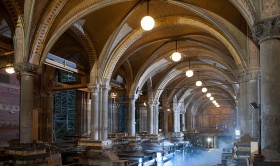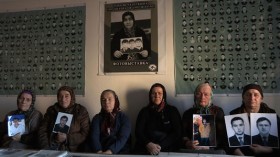… Vidnesbyrdet i litteraturen er altså mere end blot en afslørende beretning. Den adskiller sig i føste omgang gennem to afgørende tilskyndelser: at give stemme til dem, der er gjort tavse og at bevare ofrenes navne. (Horace Engdahl)
Det jeg husker fra filmen, er Jyoto Sings fortvivlede mor, som så mærkelig afklaret vidner om, hvad hun ved om forbrydelsen og i samme interview suppleret af sin mand, som helt tilsvarende afklaret rolig fortæller om datteren. Sådan var denne unge kvinde. Filmen indeholder en række vigtige interviews, nogle meget chokerende og nu vidt kommenterede over alt, hvor filmen har været vist. På DR1 blev den præsenteret således: ”Voldtægten der rystede verden. Dansk/indisk dokumentarfilm fra 2015. 23-årige Jyoti Singh er på vej hjem en tidlig aften efter et biografbesøg med en ven. De overfaldes af seks mænd bevæbnet med jernstænger. Jyoti voldtages og maltrakteres for til sidst at blive smidt nøgen på gaden. 13 dage senere dør hun af sine kvæstelser. For første gang i en dokumentarfilm fortæller Jyotis forældre og en af voldtægtsmændene om, hvad der skete og hvorfor disse brutale voldtægter finder sted i Indien.” (DR)
Det er alt sammen rigtigt, sådan er det journalistisk og historisk antropologisk betragtet, og det er vist også, hvad Leslee Udwin vælger som sin histories fokus. Moderens vidnesbyrd flytter det imidlertid for mig til hendes datters lidelses historie. Det vil mærkes længe. Jeg var i dyb forvirring efter at have set filmen, kunne ikke finde ord. Kunne ikke være alene med den film, gav mig til at læse om den. Den første forfatter havde som jeg i første omgang måttet give op inden en halv time:
”I tried to watch the BBC documentary India’s Daughter on Sunday, but I switched it off after 25 minutes. I found it too painful to watch, and too familiar. The hour-long film is about the brutal gang rape of a 23-year-old medical student. Twenty-four minutes and 10 seconds into the film, a list of physical injuries a woman endured through rape are read out to one of the men responsible for inflicting them. He sits there and says nothing. There is no reaction…” (Pavan Amara in The Independent)
http://www.independent.co.uk/news/world/asia/indias-daughter–a-reaction-from-a-victim-of-sexual-assault-in-britain-how-can-a-man-rape-a-woman-and-then-say-its-her-fault-10106871.html
“… Filmen er stilfærdig i al sin gru. Den jagter ikke sensationen. Den fortæller om et syn på kvinder helt underlagt manden og med fast plads i hjemmet. Bundet til en tilværelse hvor de ikke må leve frit, vælge frit, uddanne sig frit, gå ud med hvem de vil og søge en fremtid på lige fod med mændene. Så kan vi godt diskutere, hvor mange kvindelige topledere, vi har herhjemme, men i verdens største demokrati og det økonomisk fremstormende Indien såvel som mange andre steder i verden, ejer kvinderne ikke de mest basale frihedsrettigheder og udsættes for vold og undertrykkelse.” (Lisbeth Knudsen, Berlingske)
http://lisbethknudsen.blogs.berlingske.dk/2015/03/07/kvindekampdag-og-jyoti-singh/
”… Listening to Mukesh Singh (one of the convicts), I wasn’t surprised. Listening to the defense lawyers, I didn’t know whether to laugh, cry or vomit. Listening to the judges on the Verma Committee, a special government commission set up after Ms. Jyoti Singh’s death to enhance punishments for sexual crimes, I felt pride. Listening to the victim’s relatives, I tried to imagine their anguish and couldn’t. Listening to the rapists’ relatives, I tried to imagine their anguish and couldn’t. But I could, and I did, listen to all of them. And everyone should be able to. “(Sohaila Abdulali, a columnist for the Indian newspaper Mint, in New York Times)
http://www.nytimes.com/2015/03/13/opinion/banning-indias-daughter-is-a-terrible-idea.html?_r=0
Jo mere jeg læste, jo mere forfærdet og magtesløs blev jeg. Ved et tilfælde læste jeg også den dag, jeg så Indiens døtre, de sidste afsnit i Horace Engdahls Arret efter drømmen og i det allersidste, Philomelas tunge, som er en undersøgelse af vidnesbyrdets rolle i litteraturen fra oldtiden til nutiden, gav mig perspektivet, jeg måske kunne bruge for at fatte filmens erfaring: ”… Hvordan skal en kvinde, i en kultur hvor kvinders menneskeværd ikke tages alvorligt, gøre sine mandlige tilhørere begribeligt, hvad hendes krop er blevet udsat for? Det forekommer så trivielt, de forstår ikke, hvad hun mener. Kroppen mumler mærkeligt, ligesom Philomelas afskårne tunge.”
Indiens døtre / Indias Daughter, Danmark/Indien/England 2015, 54 min. Produceret af Plus Pictures ved Mette Heide for DR ved Mette Hoffmann Meyer og BBC Storyville. Sendt på DR1 8. marts, kan NB ses til 9. april på
https://www.dr.dk/tv/se/indiens-doetre/indiens-doetre
SYNOPSIS
“India’s Daughter is director Leslee Udwin’s stirring documentation of a crime that triggered what she has described as “an Arab Spring for gender equality” in India.
The December 2012 Delhi bus gang rape resulted in the death of 23-year-old medical student Jyoti Singh at the hands of six men. The men threw Singh and her male friend out of the bus before gleefully divvying up the pair’s belongings. One rapist got a pair of shoes, another scored a jacket. There was, however, an item that Singh had left behind which the men didn’t want. So they wrapped the innards they had wrenched out of her in their frenzy of violence in a piece of cloth, and pitched it through the window. “They had no fear,” Mukesh Singh, the driver of the bus and one of four men to be convicted for Jyoti’s rape and murder, tells Udwin.
The interview with Mukesh Singh, whose death sentence is currently in appeal, is a coup for Udwin, who is the first journalist ever allowed to talk to him, or any of the men. She will likely be the last. Yesterday the authorities banned the film in India after claiming that Udwin had failed to get the requisite permissions. Shortly afterwards the parliamentary affairs minister M Venkaiah Naidu described the film as “an international conspiracy”…
Leslee Udwin spent two years making a documentary on the horrific rape and killing of young medical student Jyoti Singh. And it asks, has the attack really spurred a sea change for gender equality in India? ” (From Sonia Faleiro’s review in The Guardian)
http://www.theguardian.com/tv-and-radio/2015/mar/05/indias-daughter-review-this-film-does-what-the-politicians-should-be-doing
PS:
JURIDISKE OG JOURNALISTISKE INDVENDINGER
Jeg er senere blevet gjort opmærksom på specielt to kritiske artikler om filmen, en juridisk, etisk og en journalistisk, etisk:
THE FILMMAKER IN THE POSITION OF AN INTERROGATOR
“Nowhere in the world would a convicted prisoner, whose appeal is still pending, be allowed to confess on national television that he was part of a gang which raped and fatally injured a young woman, that the juvenile was the one who committed the most brutal violence and that he was only driving the bus. That apart, the Indian Constitution in Article 20(3) provides a guarantee against self-incrimination. Even during investigation, the investigating authority is not permitted to question a suspect in a manner that would incriminate him. Yet, investigating agencies continue to hold suspects in custody and employ third degree methods to get information. So routine has it become for the police to hold press conferences incriminating suspects on national television before trial, that we the people now think it is fine for us to do the same. Something similar has happened with the BBC 4 film India’s Daughter on the Nirbhaya case. The filmmaker has put herself in the position of an interrogator.
And how do we know that the convict Mukesh is telling the truth? How do we know that he is not performing for the benefit of the filmmaker or a larger audience on a predetermined script? There is no way of knowing, which is why the interview with the convict is legally, and morally wrong. There is no transparency in the making of the film…” (Indira Jaising, the former Additional Solicitor General of India. She is currently the Director of the Lawyers Collective Women’s Rights Initiative)
http://www.huffingtonpost.in/indira-jaising-/documentary-violates-the-_b_6862010.html
STING STRATEGY
“… He also said that the interviewed convict, Mukesh was not comfortable talking to the TV crew, though, he had given a consent letter to the film makers, including Bhushan. When they started, they noticed that nothing much would be forthcoming from Mukesh since he was only replying in monosyllables – ‘yes’ and ‘no’. They crew decided to resort to the ‘sting strategy’.
It is learnt that a cameraperson was asked to roll the camera but pretended that it was switched off. The rapist was inveigled into an informal chat. Unaware that he was being shot, his ugly, unrepentant mindset came to the fore and Udwin could get the sensational quotes, which were used in the film. “He was not speaking, so it was decided to do a sting and use the entire set up to look like a proper interview. It was a long informal interview in which he had mentioned so many things. The crew also interviewed a few other convicts, but till that time Tihar authorities did not know the contents of Mukesh’s bytes. They saw it last year and raised objections,” said an official privy to the developments in the ongoing probe. The official also pointed out that the clothes Mukesh wore during the interview indicated that rules were violated. “If he had been convicted, he would have been wearing prison clothes,” points out a Tihar Jail official. (Yatish Yadav, filminstruktør, New Delhi)
http://www.newindianexpress.com/nation/Deception-Lies-Behind-Making-of-India%E2%80%99s-Daughter/2015/03/09/article2704869.ece




